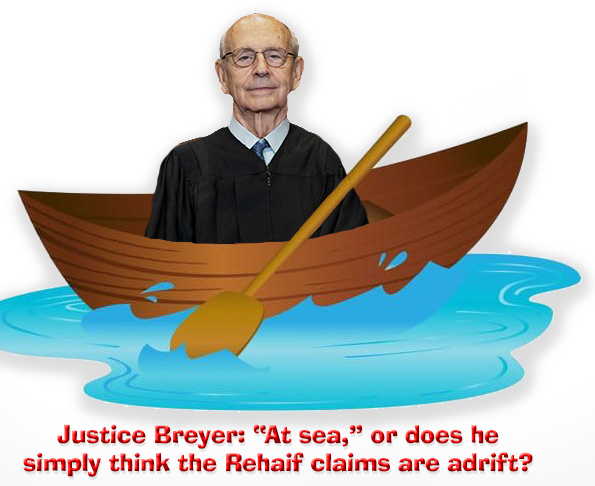We post news and comment on federal criminal justice issues, focused primarily on trial and post-conviction matters, legislative initiatives, and sentencing issues.

GOVERNMENT SEEKS CERTIORARI ON GARY DECISION
The 4th Circuit’s United States v. Gary decision, which holds that Rehaif error in a case is structural and will get the defendant an automatic reversal, is an outlier. Every other circuit deciding the question holds that a defendant challenging his conviction under Rehaif has to show that, but for the error, he would have probably would have won.
 Rehaif error, for those of you joining us late, flows from the Supreme Court’s 2019 decision in Rehaif v. United States. In that decision, the Court ruled that the crime of being a prohibited person (such as convicted felon or an alien in the United States illegally, but there are seven other categories as well). Before Rehaif, it was enough for the government to show that someone knew he or she possessed a gun while being a prohibited person. One did not have to know that he or she was “prohibited.”
Rehaif error, for those of you joining us late, flows from the Supreme Court’s 2019 decision in Rehaif v. United States. In that decision, the Court ruled that the crime of being a prohibited person (such as convicted felon or an alien in the United States illegally, but there are seven other categories as well). Before Rehaif, it was enough for the government to show that someone knew he or she possessed a gun while being a prohibited person. One did not have to know that he or she was “prohibited.”
This may seem like a distinction without a difference. Hamid Rehaif, a citizen of the United Arab Emirates, came to the U.S. lawfully to attend college. But he flunked out. Nevertheless, he remained in Melbourne, Florida, living openly and even indulging his passion for target shooting at a local gun range. When interviewed by government agents, he was cooperative and expressed his belief he was still entitled to be in the United States.
The government – being the government – didn’t just drive the cooperative Mr. Rehaif to the airport to catch Emirates’ next flight back to Dubai. That would have made too much sense. Instead, it indicted Hamid for being in illegal alien in possession of a firearm and ammunition, a violation of 18 USC §§ 922(g) and 924(a). Hamid’s lawyer did his best to defend Hamid by arguing that he had no idea he was in the United States illegally, but the trial court – based on clearly established law in the 11th Circuit (and most everywhere else) – ruled that whether Hamid knew he was prohibited from possessing a gun or ammo, or that he knew he was a member of a prohibited class under 18 USC 922(g), simply didn’t matter.

It took the Supreme Court to straighten things out (unfortunately for Hamid, two years after he finished his federal prison time and was sent home to the UAE). In Rehaif, the Court said that it was clear that the penalty language of 18 USC 924(a) – which prescribed the punishment for violating 18 USC 922(g) – required that the government prove that a defendant knew that he or she was a member of a prohibited class.
You may ask yourself, “How could someone not know he or she was a convicted felon?” It’s not that simple. The statute does not exactly say “convicted felon.” Instead, it says convicted of a crime “punishable by imprisonment for a term exceeding one year.” That phrase “punishable by imprisonment for a term exceeding one year,” in turn, is defined in 18 USC § 921(a)(20) as not including
(A) any Federal or State offenses pertaining to antitrust violations, unfair trade practices, restraints of trade, or other similar offenses relating to the regulation of business practices, or
(B) any State offense classified by the laws of the State as a misdemeanor and punishable by a term of imprisonment of two years or less.
What constitutes a conviction of such a crime shall be determined in accordance with the law of the jurisdiction in which the proceedings were held. Any conviction which has been expunged, or set aside or for which a person has been pardoned or has had civil rights restored shall not be considered a conviction for purposes of this chapter, unless such pardon, expungement, or restoration of civil rights expressly provides that the person may not ship, transport, possess, or receive firearms.
So the question is whether someone knew that he or she was convicted of (a) a crime punishable by more than a year in prison which (b)(1) was not one of the offenses related to the regulation of business practices, or (b)(2) classified by the state as a misdemeanor, or (c)(1) was expunged or (c)(2) set aside or (c)(3) for which a pardon had been issued or (c)(4) civil rights restored, unless (d) the restoration did not meet enumerated standards.
 Whew. The better question is how someone without a law degree could possibly how whether he or she was a prohibited person or not.
Whew. The better question is how someone without a law degree could possibly how whether he or she was a prohibited person or not.
That has not prevented lower courts asked to revisit § 922(g) convictions, generally but inaccurately called “felon-in-possession” convictions, from ruling that a conviction should be upheld if it was unlikely the defendant could have won even if the jury had been told the government had to prove the defendant’s knowledge. Except in the Fourth Circuit: there, the Gary decision established that Rehaif error is “structural,” that is, an error that permeates “the entire conduct of the trial from beginning to end” or “affect[s] the framework within which the trial proceeds…”
The 4th Circuit’s holding that Rehaif is structural error means that this Circuit is the place to be for people trying to get back into court on felon-in-possession charges. But the government, wanting to head that off at the pass, has filed a petition for certiorari with the Supreme Court, challenging the Gary decision. Although petitions for cert filed by defendants has about a 1% chance of grant, not so for the government. Government decisions to file for cert are not all that frequent, and the Supreme Court takes such petitions seriously.
Defendant Gary is to oppose the motion by December 8th.
United States v. Gary, Case No 20-444, Petition for Certiorari filed Oct 7, 2020
– Thomas L. Root


 Bryan Range, who had been sentenced to probation a quarter century ago for $2,500 in food stamp fraud, had sued the Attorney General for the right to buy a gun, arguing that after last June’s Supreme Court decision in New York State Rifle & Pistol Ass’n v Bruen, § 922(g)(1)’s denial of his right to own a gun because of a prior felony conviction was a 2nd Amendment violation.
Bryan Range, who had been sentenced to probation a quarter century ago for $2,500 in food stamp fraud, had sued the Attorney General for the right to buy a gun, arguing that after last June’s Supreme Court decision in New York State Rifle & Pistol Ass’n v Bruen, § 922(g)(1)’s denial of his right to own a gun because of a prior felony conviction was a 2nd Amendment violation. The speed with which the full Court ordered rehearing – just three days after Bryan filed his petition – suggests a majority of the judges on the Circuit are very motivated by the issue. Ohio State University law professor Doug Berman, writing yesterday in his Sentencing Law and Policy blog, observed, “I do not know enough about the particulars of all the Third Circuit judges to make confident predictions about how Range will be resolved after en banc reconsideration. But, generally speaking, full circuits do not take up issues en banc when most of the judges are generally content with the panel outcome.”
The speed with which the full Court ordered rehearing – just three days after Bryan filed his petition – suggests a majority of the judges on the Circuit are very motivated by the issue. Ohio State University law professor Doug Berman, writing yesterday in his Sentencing Law and Policy blog, observed, “I do not know enough about the particulars of all the Third Circuit judges to make confident predictions about how Range will be resolved after en banc reconsideration. But, generally speaking, full circuits do not take up issues en banc when most of the judges are generally content with the panel outcome.”























